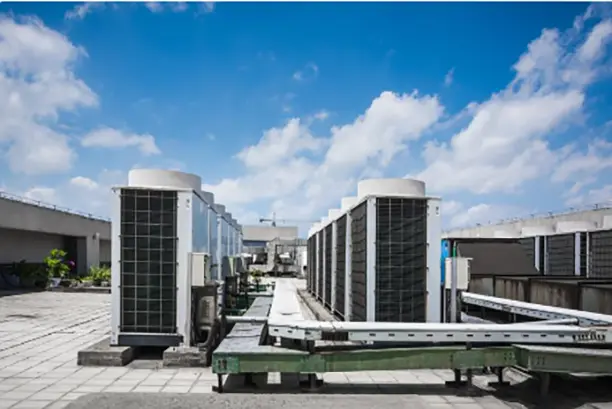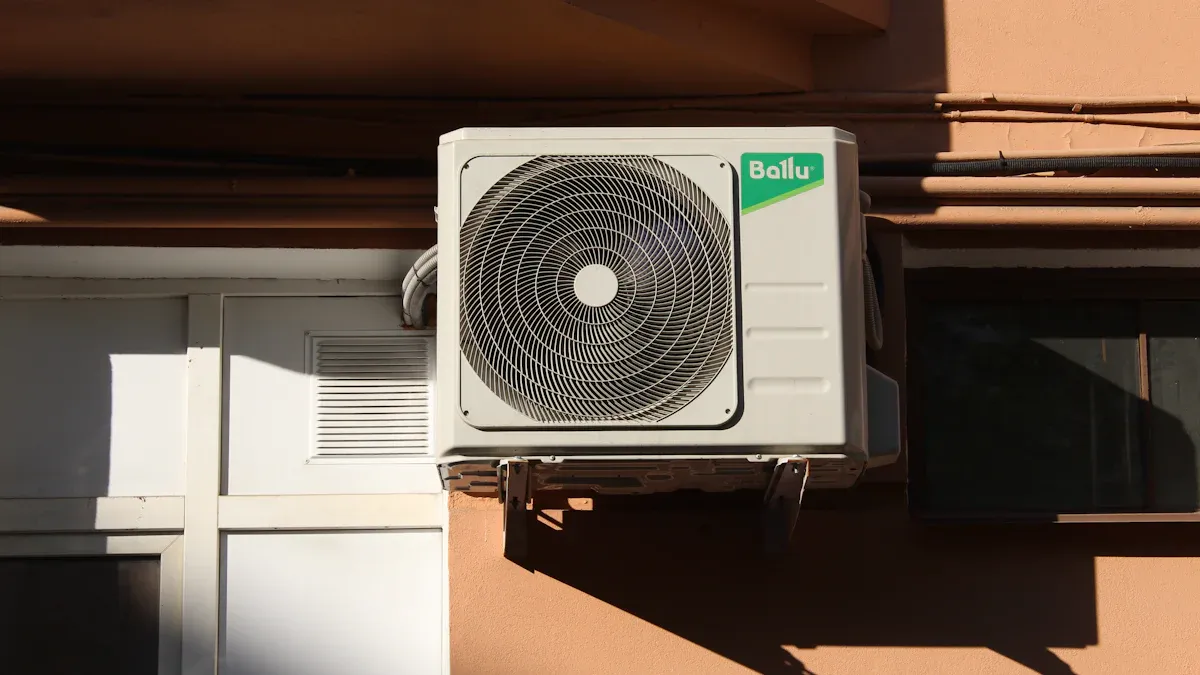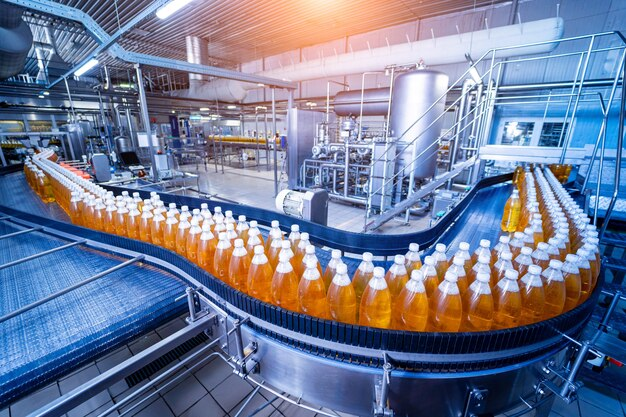2025 Global Refrigeration Industry White Paper: Heat Exchanger Innovations & Market Opportunities

Heat exchanger innovations have revolutionized the refrigeration industry in 2025. Key developments include advancements in materials and designs, which have contributed to the growth of the global heat exchanger market. For instance:
- The microchannel heat exchanger market is projected to grow from $14.22 billion in 2024 to $15.6 billion in 2025, with a CAGR of 9.7%.
- The global heat exchanger market is expected to expand from $18.5 billion in 2023 to over $33.1 billion by 2032, driven by energy efficiency demands.
These innovations, such as the Copper Fin Heat Exchanger, are reshaping refrigeration systems by improving performance and meeting stricter energy standards. Stakeholders now have a unique opportunity to capitalize on this growth trajectory.
Key Takeaways
- New heat exchanger designs are changing the refrigeration industry.
- Better materials and designs make them work faster and save energy.
- Using energy-saving heat exchangers can cut costs and follow eco-rules.
- Smart technology in heat exchangers tracks performance in real-time.
- This makes them more reliable and helps them last longer.
Heat Exchanger Innovations in 2025

Breakthrough Materials and Designs
In 2025, the refrigeration industry has embraced groundbreaking materials and designs that redefine heat exchanger performance. I’ve observed that fusion-bonded plate heat exchangers stand out as a prime example. These exchangers utilize AlfaFusion bonding technology, which enhances efficiency while maintaining a compact form. Constructed entirely from stainless steel, they offer 100% recyclability and exceptional resistance to corrosion, even when exposed to aggressive media. Their ability to handle high pressures and temperatures makes them ideal for demanding applications, such as clean water refrigeration and tap water heating systems.
These innovations demonstrate how advanced materials and engineering can address the growing need for sustainable and durable solutions. By adopting such designs, manufacturers can meet the increasing demand for high-performance refrigeration systems.
Energy Efficiency Improvements
Energy efficiency remains a top priority in the refrigeration sector. I’ve noticed that modern heat exchangers now incorporate advanced thermal management systems to minimize energy consumption. For instance, optimized surface geometries and enhanced heat transfer coefficients allow these systems to operate with reduced energy input. This not only lowers operational costs but also aligns with global efforts to reduce carbon footprints.
The integration of energy-efficient heat exchangers into refrigeration systems has become a game-changer. It enables businesses to achieve significant energy savings while complying with stringent environmental regulations.
Integration with Sustainable Refrigerants
The shift toward sustainable refrigerants has driven innovation in heat exchanger technology. I’ve seen how manufacturers design exchangers to work seamlessly with eco-friendly refrigerants like R-32 and R-290. These refrigerants have lower global warming potential (GWP) compared to traditional options, making them a preferred choice for environmentally conscious applications.
Heat exchangers optimized for sustainable refrigerants ensure compatibility without compromising performance. This integration supports the industry’s transition to greener solutions, paving the way for a more sustainable future.
Smart and IoT-Enabled Heat Exchangers
The rise of smart technology has transformed heat exchangers into intelligent systems. I’ve observed how IoT-enabled exchangers now feature sensors and connectivity options that allow real-time monitoring and control. These systems provide valuable insights into performance metrics, enabling predictive maintenance and reducing downtime.
For example, smart heat exchangers can detect anomalies in operation and alert technicians before a failure occurs. This proactive approach enhances system reliability and extends the lifespan of refrigeration equipment.
The Role of Copper Fin Heat Exchangers
Copper Fin Heat Exchangers have emerged as a cornerstone of modern refrigeration systems. Their superior thermal conductivity and corrosion resistance make them a reliable choice for various applications. I’ve seen how these exchangers excel in transferring heat efficiently, ensuring optimal performance even under challenging conditions.
Ningbo Senjun New Materials Co., Ltd., a leader in this field, has made significant strides in developing high-quality Copper Fin Heat Exchangers. Their products cater to a wide range of applications, including refrigerators, freezers, and medical ultra-low temperature refrigerators. By leveraging advanced manufacturing techniques, Senjun delivers exchangers that meet the industry’s evolving demands for efficiency and durability.
Applications of Heat Exchanger Innovations

Commercial Refrigeration Systems
I’ve seen how heat exchanger innovations have transformed commercial refrigeration systems. Businesses now rely on advanced plate heat exchangers to meet energy efficiency regulations in North America and Europe. These systems reduce carbon emissions while maintaining optimal cooling performance. Their compact size and high thermal efficiency make them ideal for supermarkets, restaurants, and food storage facilities.
Industrial Cooling and Processing
Industrial cooling and processing applications have greatly benefited from innovative heat exchangers. The market for these systems grew from $19.25 billion in 2024 to $20.51 billion in 2025, with a projected CAGR of 6.0% through 2034. Industries like chemical processing and power generation favor these exchangers for their ability to recover waste heat efficiently. In Asia Pacific, the anticipated CAGR of 5.9% highlights the growing demand for these technologies in industrial settings.
| Metric | Value |
|---|---|
| Market size in 2024 | USD 19.25 billion |
| Projected market size in 2025 | USD 20.51 billion |
| Projected market size by 2034 | USD 36.60 billion |
| CAGR from 2025 to 2034 | 6.0% |
| Revenue share of chemical & petrochemical segment in 2024 | 24.5% |
| Anticipated CAGR in Asia Pacific from 2025 to 2034 | 5.9% |
Residential and Consumer Applications
In residential settings, I’ve noticed that heat exchangers play a critical role in refrigerators, air conditioners, and dehumidifiers. Their compact designs and energy-saving capabilities make them a preferred choice for consumers. Copper Fin Heat Exchangers, known for their durability and thermal conductivity, ensure reliable performance in these everyday appliances.
Cold Chain Logistics and Storage
Cold chain logistics depend on efficient heat exchangers to maintain precise temperature control. I’ve observed their widespread use in medical ultra-low temperature refrigerators and display cabinets. These systems ensure the safe storage and transportation of perishable goods, pharmaceuticals, and vaccines.
Contributions of senjun to Heat Exchanger Applications
Ningbo Senjun New Materials Co., Ltd. has emerged as a leader in heat exchanger applications. Their Copper Fin Heat Exchangers cater to diverse needs, from commercial refrigeration to medical equipment. By prioritizing innovation and quality, Senjun supports industries in achieving energy efficiency and sustainability goals.
Market Trends and Opportunities
Growth in Emerging Markets
Emerging markets are driving significant growth in the global heat exchanger industry. I’ve observed that rising industrialization and urbanization in countries like India, Brazil, and Indonesia have created a surge in demand for efficient heating and cooling equipment. These regions are rapidly adopting advanced refrigeration systems to support expanding industries such as food processing, pharmaceuticals, and manufacturing.
- The global heat exchanger market is estimated to reach USD 20,837.1 million in 2025 and grow to USD 29,594.6 million by 2032.
- Increased utilization of heat exchangers in residential and commercial buildings is a key factor fueling this growth.
- Industries like chemical processing and renewable energy projects are also contributing to the rising demand.
This trend highlights the untapped potential in developing economies, offering stakeholders opportunities to expand their market presence and invest in localized production facilities.
Demand for Energy-Efficient Solutions
Energy efficiency has become a cornerstone of the refrigeration industry. I’ve noticed that businesses and consumers alike are prioritizing solutions that reduce energy consumption and operational costs. Heat exchangers play a pivotal role in achieving these goals by optimizing thermal management systems.
| Category | Energy Savings/Impact |
|---|---|
| Heating and cooling | 43% of utility costs |
| Upgrading heating/cooling | Reduces energy use by 20–50% |
| Sealing drafts | Results in 5–30% savings annually |
| Storm windows | Minimizes heat loss by 25–50% |
These statistics underscore the importance of energy-efficient technologies. By upgrading to advanced heat exchangers, businesses can achieve substantial energy savings while meeting environmental standards. Copper Fin Heat Exchangers, known for their superior thermal conductivity, are particularly effective in reducing energy use across various applications.
Regulatory Drivers and Compliance
Stricter environmental regulations are reshaping the heat exchanger market. Governments worldwide are enforcing policies to reduce greenhouse gas emissions and promote energy efficiency. I’ve seen how these regulations are compelling manufacturers to innovate and adopt sustainable practices.
For example, the integration of eco-friendly refrigerants like R-32 and R-290 into heat exchanger systems aligns with global efforts to combat climate change. Companies that comply with these regulations not only avoid penalties but also gain a competitive edge by appealing to environmentally conscious consumers.
Investment in R&D and Technology Partnerships
Investments in research and development are accelerating innovation in the heat exchanger industry. I’ve observed that companies are forming strategic partnerships to develop cutting-edge technologies. These collaborations focus on enhancing efficiency, durability, and sustainability.
| Company | Focus Area | Impact on Market |
|---|---|---|
| Kelvion | Compact and modular heat exchangers | Reduced material usage by up to 20% |
| Mersen | Corrosion-resistant materials | Extended lifespan of heat exchangers in harsh environments |
| Alfa Laval | Partnerships in renewable energy | Development of heat exchangers for solar and geothermal applications |
| Danfoss | IoT-enabled heat exchangers | Enhanced operational efficiency through collaborations |
These investments are driving the development of innovative solutions, such as IoT-enabled heat exchangers, which offer real-time monitoring and predictive maintenance capabilities. By prioritizing R&D, companies can stay ahead of market trends and deliver value to their customers.
senjun's Role in Market Growth
Ningbo Senjun New Materials Co., Ltd. has established itself as a key player in the heat exchanger market. I’ve seen how their commitment to innovation and quality has positioned them as a leader in the industry. Senjun specializes in Copper Fin Heat Exchangers, which cater to a wide range of applications, including refrigerators, freezers, and medical ultra-low temperature refrigerators.
By leveraging advanced manufacturing techniques, Senjun delivers products that meet the growing demand for energy-efficient and durable solutions. Their focus on sustainability and performance aligns with market trends, making them a trusted partner for businesses worldwide.
Challenges and Considerations
Cost and Scalability of New Technologies
I’ve observed that the cost and scalability of new heat exchanger technologies remain significant challenges in 2025. Advanced solutions, such as printed circuit heat exchangers, offer exceptional performance but come with steep price tags.
- These technologies are considerably more expensive than traditional options, making them less accessible in price-sensitive markets.
- Their intricate manufacturing processes require specialized techniques, which elevate production costs and limit scalability.
These factors create barriers for widespread adoption, especially in emerging economies. Manufacturers must find ways to streamline production and reduce costs to make these innovations more viable for global markets.
Supply Chain and Material Availability
Material availability has become a critical concern for heat exchanger manufacturers. I’ve noticed that the demand for high-quality materials, such as copper and aluminum, has surged due to their superior thermal conductivity and durability. However, supply chain disruptions have led to shortages and price volatility.
Global events, such as geopolitical tensions and natural disasters, exacerbate these challenges. Companies must diversify their sourcing strategies and invest in sustainable alternatives to mitigate risks. By adopting proactive measures, manufacturers can ensure a steady supply of materials and maintain production continuity.
Balancing Innovation with Regulatory Compliance
Balancing innovation with regulatory compliance is a delicate task for industry players. Stricter regulations on energy efficiency and safety have reshaped the heat exchanger market. I’ve seen how these rules encourage companies to innovate while adhering to standards.
| Key Aspect | Description |
|---|---|
| Regulatory Influence | The heat exchangers market is heavily influenced by regulations on energy efficiency and safety. |
| Innovation Encouragement | Stricter regulations drive companies to innovate in order to comply with standards. |
| Competitive Environment | Regulatory compliance fosters competition among industry players, leading to advancements. |
This dynamic fosters a competitive environment where companies strive to develop cutting-edge solutions that meet regulatory requirements. By aligning innovation with compliance, manufacturers can gain a competitive edge and contribute to a sustainable future.
Heat exchanger innovations in 2025 have reshaped the refrigeration industry. I’ve seen how advancements in materials, energy efficiency, and IoT integration have driven significant growth. These technologies align with global sustainability goals and open doors for stakeholders to capitalize on emerging markets.
📊 Key Performance Indicators
Key Performance Indicators Description Market Growth Rates The heat exchanger market is expected to experience substantial expansion by 2025, driven by end-use industries and renewable energy adoption. Technological Advancements Innovations in material science and predictive maintenance are enhancing system performance and lifecycle management. Energy Efficiency Focus There is a strong emphasis on developing energy-efficient and sustainable solutions, aligning with global trends towards sustainability.
I encourage industry professionals to seize these opportunities by investing in R&D, forming strategic partnerships, and adopting cutting-edge solutions. Together, we can drive innovation and sustainability forward.
FAQ
What are the key benefits of Copper Fin Heat Exchangers?
Copper Fin Heat Exchangers offer superior thermal conductivity, excellent corrosion resistance, and durability. These features ensure efficient heat transfer and reliable performance across various refrigeration applications.
How does IoT integration improve heat exchanger performance?
IoT integration enables real-time monitoring, predictive maintenance, and anomaly detection. These capabilities enhance system reliability, reduce downtime, and extend the lifespan of refrigeration equipment.
Why is energy efficiency critical in heat exchanger design?
Energy efficiency reduces operational costs and aligns with global sustainability goals. Advanced designs optimize thermal management, minimizing energy consumption while meeting environmental regulations.


















